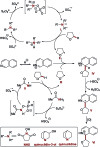Direct Cα-heteroarylation of structurally diverse ethers via a mild N-hydroxysuccinimide mediated cross-dehydrogenative coupling reaction
- PMID: 30155212
- PMCID: PMC6094177
- DOI: 10.1039/c6sc05697k
Direct Cα-heteroarylation of structurally diverse ethers via a mild N-hydroxysuccinimide mediated cross-dehydrogenative coupling reaction
Abstract
An important challenge in the Cα-heteroarylation of ethers is the requirement of a large excess amount of ethers (that are used as solvents in many cases) to achieve effective transformations. This drawback has significantly restricted the Cα-heteroarylation of ethers to the use of simple and easily accessible ether substrates. To overcome this limitation, a new, efficient, N-hydroxysuccinimide (NHS) mediated, mild and metal-free CDC strategy for the direct Cα-heteroarylation of diverse ethers has been developed. Different to our previous benzaldehyde mediated photoredox Cα-heteroarylation, we have identified NHS as a new and efficient mediator without using light. A distinct non-photoredox engaged hydrogen-atom-transfer (HAT) mechanism that used a nitrogen-centered radical cation produced from NHS is initially revealed. Notably, only 5-10 equivalents of ethers as coupling partners are used, which allows for structurally diverse and complex ethers to engage in this process, to create highly medicinally relevant Cα-heteroarylated ethers. Furthermore, more structurally diverse heterocyclics can serve as reactants for this process.
Figures
References
-
-
For selected reviews and examples of functionalized ethers in bioactive natural products and synthetic pharmaceuticals, see:
- Nakata T. Chem. Rev. 2005;105:4314–4347. - PubMed
- Kang E. J., Lee E. Chem. Rev. 2005;105:4348–4378. - PubMed
- Roughley S. D., Jordan A. M. J. Med. Chem. 2011;54:3451–3479. - PubMed
- Taylor R. D., MacCoss M., Lawson A. D. G. J. Med. Chem. 2014;57:5845–5859. - PubMed
-
-
-
For selected examples of Cα-heteroarylated ethers in bioactive molecules, see:
- Wang G., Wan J., Hu Y., Wu X., Prhavc M., Dyatkina N., Rajwanshi V. K., Smith D. B., Jekle A., Kinkade A., Symons J. A., Jin Z., Deval J., Zhang Q., Tam Y., Chanda S., Blatt L., Beigelman L. J. Med. Chem. 2016;59:4611–4624. - PubMed
- Park Y., Bae S. Y., Hah J. M., Lee S. K., Ryu J. S. Bioorg. Med. Chem. 2015;23:6827–6843. - PubMed
- Ogawa S., Watanabe T., Sugimoto I., Moriyuki K., Goto Y., Yamane S., Watanabe A., Tsuboi K., Kinoshita A., Kigoshi H., Tani K., Maruyama T. ACS Med. Chem. Lett. 2016;7:306–311. - PMC - PubMed
- Chen J.-J., Liu Q., Yuan C., Gore V., Lopez P., Ma V., Amegadzie A., Qian W., Judd T. C., Minatti A. E., Brown J., Cheng Y., Xue M., Zhong W., Dineen T. A., Epstein O., Human J., Kreiman C., Marx I., Weiss M. M., Hitchcock S. A., Powers T. S., Chen K., Wen P.-H., Whittington D. A., Cheng A.-C., Bartberger M. D., Hickman D., Werner J. A., Vargas H. M., Everds N. E., Vonderfecht S. L., Dunn R. T., Wood S., Fremeau R. T., White R. D., Patel V. F. Bioorg. Med. Chem. Lett. 2015;25:767–774. - PubMed
- Sperber N., Papa D., Schwenk E., Sherlock M. J. Am. Chem. Soc. 1949;71:887–890. - PubMed
-
-
-
For selected reviews of cross-dehydrogenative coupling (CDC) reactions, see:
- Scheuermann C. J. Chem.–Asian J. 2010;5:436–451. - PubMed
- Yoo W. J., Li C.-J. Top. Curr. Chem. 2010;292:281–302. - PubMed
- Yeung C. S., Dong V. M. Chem. Rev. 2011;111:1215–1292. - PubMed
- Girard S. A., Knauber T., Li C.-J. Angew. Chem., Int. Ed. 2014;53:74–100. - PubMed
-
-
-
For recent examples of the Cα-heteroarylation of ethers via transition-metal based oxidative CDC reactions, see:
- Salman M., Huang X.-F., Huang Z.-Z. Synlett. 2015;26:1391–1394.
- Xie Z.-Y., Cai Y.-P., Hu H.-W., Lin C., Jiang J.-L., Chen Z.-X., Wang L.-Y., Pan Y. Org. Lett. 2013;15:4600–4603. - PubMed
- Correa A., Fiser B., Bengoa E. G. Chem. Commun. 2015;51:13365–13368. - PubMed
- Jin L.-K., Wan L., Feng J., Cai C. Org. Lett. 2015;17:4726–4729. - PubMed
- Li Y.-R., Wang M.-S., Fan W., Qian F., Li G.-G., Lu H.-J. J. Org. Chem. 2016;81:11743–11750. - PubMed
-
LinkOut - more resources
Full Text Sources
Other Literature Sources
Molecular Biology Databases




